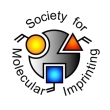
Authors: Bagheri H, Piri-Moghadam H
Article Title: Electroentrapment of Polyaniline in [3-(2,3-Epoxypropoxy)propyl]trimethoxysilane-Derived Xerogel: A Facile Methodology Towards Molecularly Imprinted Xerogels.
Publication date: 2014
Journal: Chromatographia
Volume: 77
Issue: (17-18)
Page numbers: 1185-1194.
DOI: 10.1007/s10337-014-2703-z
Abstract: A novel polyaniline (PANI)/silica hybrid composite, as a selective coating, was synthesized by the simultaneous sol-gel process and in situ electro-polymerization of aniline and employed for imprinting naproxen. The synthesized composite was chemically bonded inside a copper tube for online capillary microextraction (CME) in combination with high-performance liquid chromatography (HPLC). The copper tube was intended for use as an unbreakable substrate for CME and the HPLC injection loop. Four copper tubes containing different coatings were prepared accordingly to achieve the most appropriate extracting medium for naproxen. Coating 1 was a xerogel of [3-(2,3-epoxypropoxy)propyl]trimethoxysilane (EPPTMOS) synthesized by sol-gel technology and PANI as a conductive polymer (CP) was electrochemically prepared as coating 2. Coating 3 (sol-gel-CP) included the electroentrapped PANI into the xerogel of EPPTMOS, representing the non-imprinted xerogel (NIX) and coating 4, the molecularly imprinted xerogel (MIX), contained entrapped PANI into the xerogel of EPPTMOS, while naproxen template was already imprinted into the composite structure. Extraction efficiency of MIX towards naproxen was about 4-30 times greater than the others. Electroentrapped PANI into the silica xerogel might be responsible for the enhanced extraction efficiency, originating from high surface area of PANI as well as its role in π-π interactions. The mild conditions used in this process enabled the incorporation of organic species such as PANI into the silica particles without degradation. The main advantage of addition of PANI during the sol-gel process was the reduction of gelation time from more than a week to a few hours and, therefore, achieving a facile and controllable method for preparation of selective media. Furosemide, clodinafop-propargyl and haloxyfop-etotyl were also selected to investigate selectivity of the prepared MIX towards naproxen. Ratio of MIX/NIX, a criterion of selectivity, was 3.8, 1.1, 1.2, and 1.4 for naproxen, clodinafop, haloxyfop and furosemide, respectively. The linearity of the HPLC method for naproxen was in the range of 10-1,000 μg L-1. The limit of detection value was found to be 5 μg L-1 and RSD % of 2.9 (n = 5) was obtained. Real samples such as blood plasma and urine species were analyzed by the developed method and the relative recovery percentages of 76 and 94 % were obtained for the spiked samples
Template and target information: naproxen
Author keywords: column liquid chromatography, Capillary microextraction, Silica, polyaniline, Molecularly imprinted xerogel, sol-gel technique



Join the Society for Molecular Imprinting

New items RSS feed
Sign-up for e-mail updates:
Choose between receiving an occasional newsletter or more frequent e-mail alerts.
Click here to go to the sign-up page.
Is your name elemental or peptidic? Enter your name and find out by clicking either of the buttons below!
Other products you may like:
 MIPdatabase
MIPdatabase









